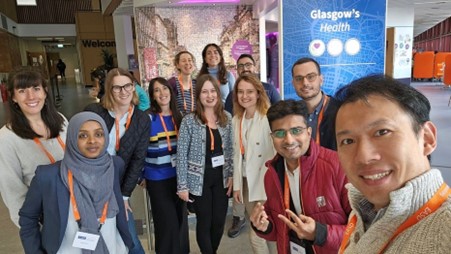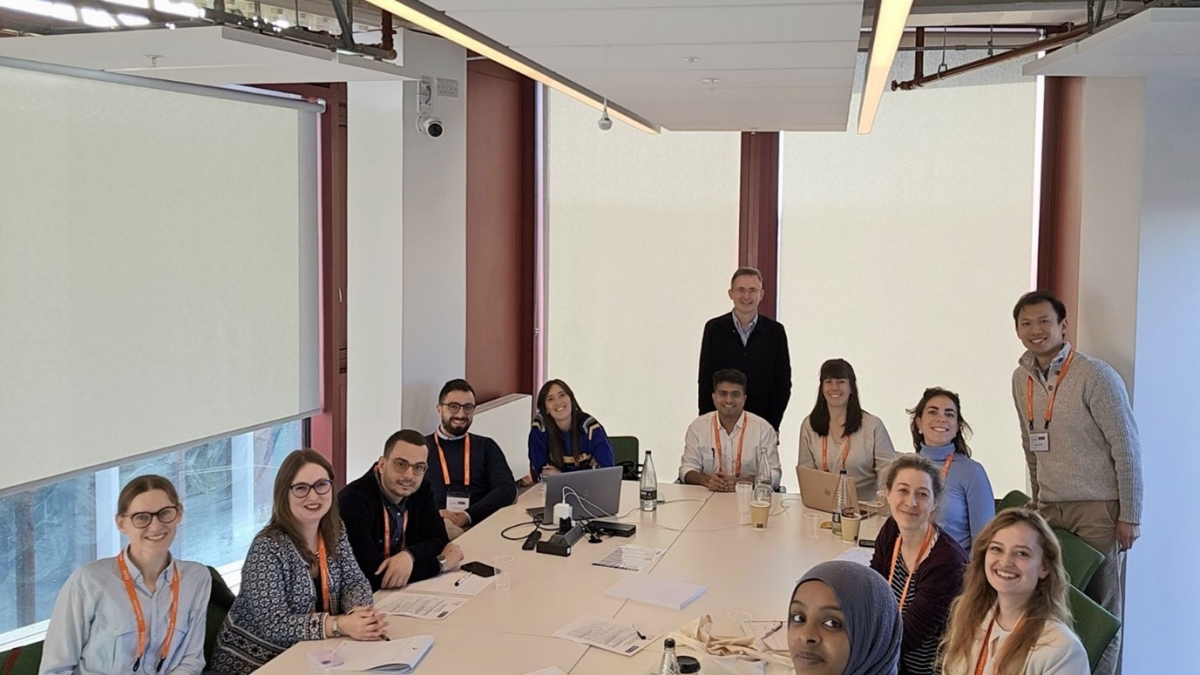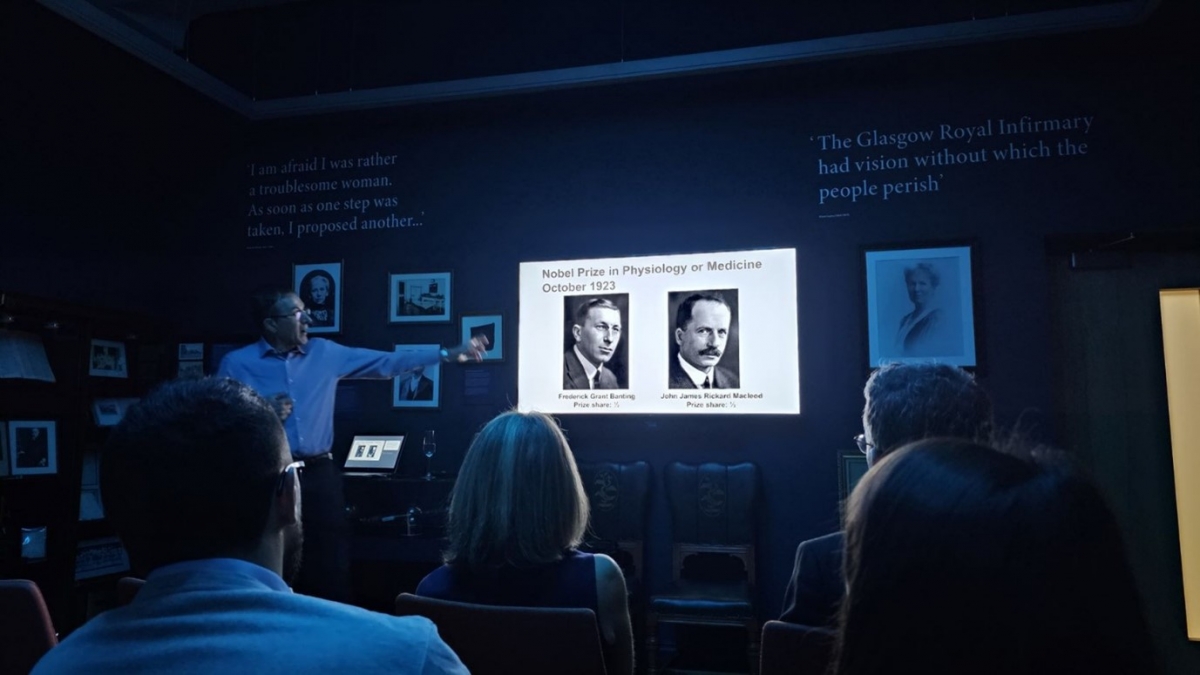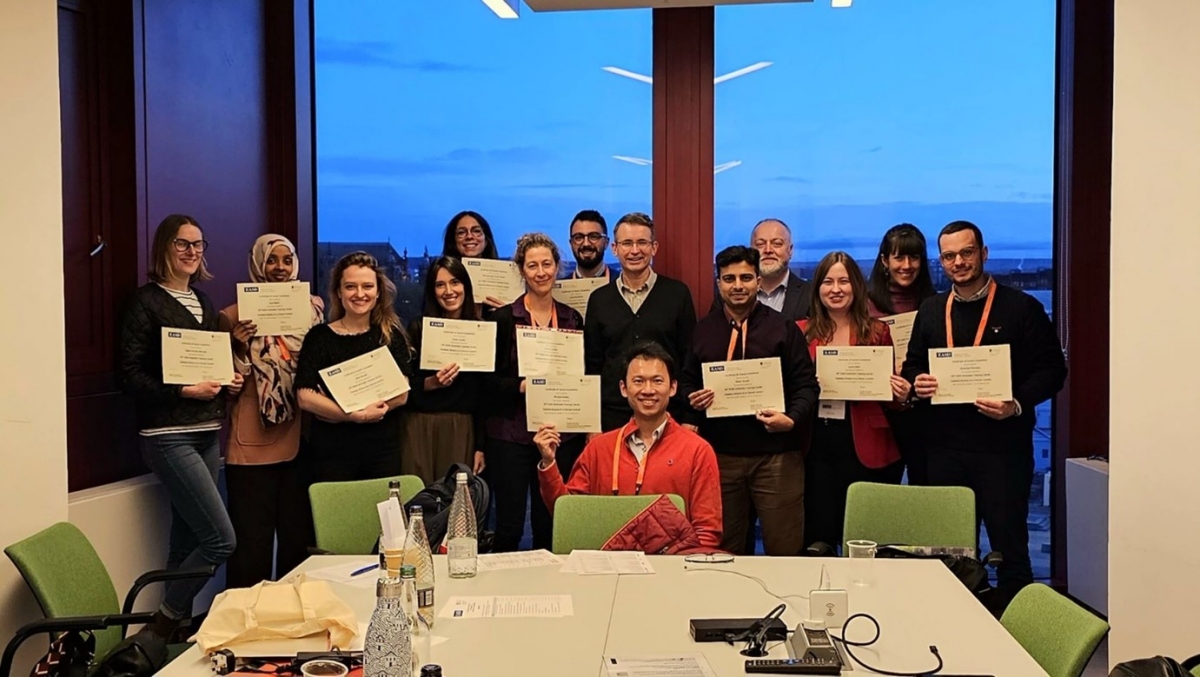Report on the 29th EASD Scientists Training Course 2023
Diabetes Science in a Clinical Context
6 - 10 November 2023 at the University of Glasgow, UK
Course organisers: Prof John Petrie, Dr James Boyle
Organising Committee: David Carty, Gemma Currie, Sharon Mackin.
Faculty: Prof Naveed Sattar, Prof Mike Lean, Prof Frances Mair, Prof Christian Delles, Prof Miles Fisher, Prof Ewan Pearson, Dr Robbie Lindsay (and others)
 We started the course on Monday evening at the hotel with a warm welcome from the course leads Professor John Petrie and Dr James Boyle, and from Mary Hata.
We started the course on Monday evening at the hotel with a warm welcome from the course leads Professor John Petrie and Dr James Boyle, and from Mary Hata.
After a short reception, Professor Sattar gave us a lecture on the complex role that ectopic and excess adipose tissue plays in the development of disease. Whilst not traditionally thought of as a complication of diabetes, the role of obesity in propagating rates of heart failure in those with diabetes, for example, became clear as his talk progressed. There was a healthy discussion about what clinical tools may be used to detect ectopic fat, including waist circumference, lipid levels and liver function, and a discussion on the utility of a clinical diagnosis of metabolically active fatty liver disease for risk stratification. The participants and course organisers continued discussion over dinner in the hotel.
We started Tuesday with an overview of diabetes clinical priorities in Scotland from Dr Brian Kennon, the national lead for diabetes in Scotland. We learnt about the 8 priority areas to help improve the lives of people with diabetes and were able to really think about how policy influences research. Dr Kennon’s talk also gave us plenty of food for thought to help with our own research plans, as on days 2 and 3 we engaged in collaborative group work, tasked with the creation of a clinical trial design.
Despite the constraints of time, our collective brainstorming efforts yielded results, leading to the development of four distinct drafts for clinical trials in diverse domains. These encompassed newly diagnosed diabetes in young individuals, cognitive disorders in older people with diabetes, post-natal screening for diabetes in those with gestational diabetes, and the integration of cutting-edge technologies. This exercise not only honed our teamwork capabilities but also nurtured the growth of our creative thinking.
On Tuesday afternoon Dr David McAllister gave us a masterclass on trial design and the uses of real world data. With a clinical focus in mind, we explored how both trial derived efficacy estimates and the natural history model are used to provide absolute effect estimates (including cost-effectiveness) in treatment recommendations.
 Throughout the course, we had the opportunity to share insights into our ongoing research projects, encompassing a remarkably diverse array of topics. Our individual participant presentations spanned the spectrum, from the intricacies of clinical research and data analysis of expansive databases to the fundamental exploration of basic science and the quest for novel biomarkers. This experience not only broadened our collective understanding but also served as a great occasion for building connections and fostering networking among the participants. We anticipate that these connections will pave the way for future international collaborations, promising innovative and impactful contributions to the world of diabetes research.
Throughout the course, we had the opportunity to share insights into our ongoing research projects, encompassing a remarkably diverse array of topics. Our individual participant presentations spanned the spectrum, from the intricacies of clinical research and data analysis of expansive databases to the fundamental exploration of basic science and the quest for novel biomarkers. This experience not only broadened our collective understanding but also served as a great occasion for building connections and fostering networking among the participants. We anticipate that these connections will pave the way for future international collaborations, promising innovative and impactful contributions to the world of diabetes research.
On Tuesday evening, we were treated to a private tour of the renowned Hunterian Museum in the beautiful quadrangle of the University of Glasgow. Entering the museum from the iconic cloisters, we were first greeted by the magnificent remnants of the Roman Antonine Wall - the northern frontier of the Roman Empire. Relevant to clinical research, we were then guided through the remarkable collection of pathological and anatomical specimens, and clinical and teaching tools by the famous Scottish obstetrician, Dr. William Hunter. The Hunterian Museum is also home to many historic artefacts and artworks. It’s was an eye opener and one of the many highlights of the course!
Dr. David Carty took us on an inspiring journey across the technological developments in diabetes, from the first injection of insulin in 1922 and the first insulin pen which was developed in Glasgow, to the modern management of patients with type 1 diabetes mellitus. Since continuous glucose monitoring (CGM) and automated insulin delivery (AID) systems have become the norm in diabetes care, the discussion highlighted the main ideas of the 2022 Consensus Report of the Joint Diabetes Technology Working Group of the EASD and the ADA, with Professor John Petrie as one of the authors, the remarkable AiDAPT study and the mechanisms, advantages and disadvantages of current and future devices such as the bionic pancreas.
 In a captivating presentation held at the Glasgow Royal Infirmary Museum, University of Glasgow, Professor Miles Fisher illuminated the historical significance of the first insulin synthesis and clinical application. His meticulously researched and eloquently delivered lecture transported the audience back in time to this critical moment in medical history with a deep understanding of the pioneering work carried out by Sir Frederick Banting, Professor John Macleod, James Collip and Charles Best. Through vivid storytelling and compelling visuals, he demonstrated the profound impact of this medical milestone not only in Glasgow but across the globe.
In a captivating presentation held at the Glasgow Royal Infirmary Museum, University of Glasgow, Professor Miles Fisher illuminated the historical significance of the first insulin synthesis and clinical application. His meticulously researched and eloquently delivered lecture transported the audience back in time to this critical moment in medical history with a deep understanding of the pioneering work carried out by Sir Frederick Banting, Professor John Macleod, James Collip and Charles Best. Through vivid storytelling and compelling visuals, he demonstrated the profound impact of this medical milestone not only in Glasgow but across the globe.
Bringing together their extensive expertise, Dr. Robert Lindsay and Dr. Sharon Mackin joined forces to present a comprehensive overview of diabetes and pregnancy. During his lecture, Dr. Lindsay delved into the pathophysiology of gestational diabetes and emphasized the pivotal role of intrauterine programming for the development of metabolic diseases later in life. His presentation underscored diabetes in pregnancy as a window of opportunity to break the transgenerational cycle of diabetes. Meanwhile, Dr. Mackin focused on perinatal complications and demonstrated beneficial effects of innovative therapeutic approaches like CGM use in pregnancies affected by T2DM and hybrid closed loop systems in pregnant women with T1DM.
An illuminating lecture by Professor Ewan Pearson explored the precision medicine approach to unravel the phenotypic and genetic heterogeneity of type 2 diabetes. Professor Pearson described how individual data from a large Scottish database were used to elaborate an algorithm to predict drug response, progression to insulin and development of micro- and macrovascular complications. Also, notions concerning the interpretation of genetic variants and their clinical implications enriched this talk, providing an insightful vision on the future of diabetes care. Professor Mike Lean then outlined the results of the DiRECT trial.
Professor Christian Delles and Dr. Gemma Currie gave an outstanding lecture regarding diabetic kidney disease, which represents a priority in the therapeutic management of diabetes, based on the fact that it accounts for almost half of cases of established chronic kidney disease worldwide. Prof. Delles emphasised the appropriate use of genomics/transcriptomics, proteomics and metabolomics for the early identification of patients at high risk of diabetic kidney disease, while Dr. Currie provided a clinician’s perspective concerning diagnosis and treatment of diabetic kidney disease in the clinical setting.
Professor Jason Gill delivered a captivating lecture titled "Exercises and Diabetes," emphasizing the immediate impact of physical activity on glycemic control and its long-term benefits on cardiovascular risk. It's noteworthy that people with diabetes with strong muscular strength show a cardiovascular risk profile comparable to those without diabetes. Moreover, he presented data showcasing the usefulness of exercise in reducing visceral fat and, notably, in decreasing liver fat deposits. Additionally, Professor Gill underscored the socioeconomic aspect and its implications for life expectancy. He pointed out that individuals who are wealthy and have cardiovascular risk factors tend to have a longer life expectancy compared to those who are economically disadvantaged with similar risk factors. It was intriguing that the correlation between socioeconomic status and life expectancy adds complexity to the discussion, shedding light on the disparities in health outcomes across different segments of society.
O n the last day of the course, we had the opportunity to focus on type 1 diabetes. Professor John Petrie devoted his lecture to adjunct therapies in type 1 diabetes, presenting the results of the REMOVAL Trial. It was an hour full of reviews of the effects of metformin in people with T1D. We received an excellent overview of the results of the REMOVAL Trial itself, as well as a summary of the publications that followed the trial, and some hints and tips from Professor Petrie on how to run a clinical trial effectively.
n the last day of the course, we had the opportunity to focus on type 1 diabetes. Professor John Petrie devoted his lecture to adjunct therapies in type 1 diabetes, presenting the results of the REMOVAL Trial. It was an hour full of reviews of the effects of metformin in people with T1D. We received an excellent overview of the results of the REMOVAL Trial itself, as well as a summary of the publications that followed the trial, and some hints and tips from Professor Petrie on how to run a clinical trial effectively.
Thank you very much to course organisers Professor Petrie and Dr Boyle, to the faculty and the organising committee of the EASD. We especially thank Eli Lilly for their generous support, enabling this enriching learning environment and networking platform for us early career scientists.
